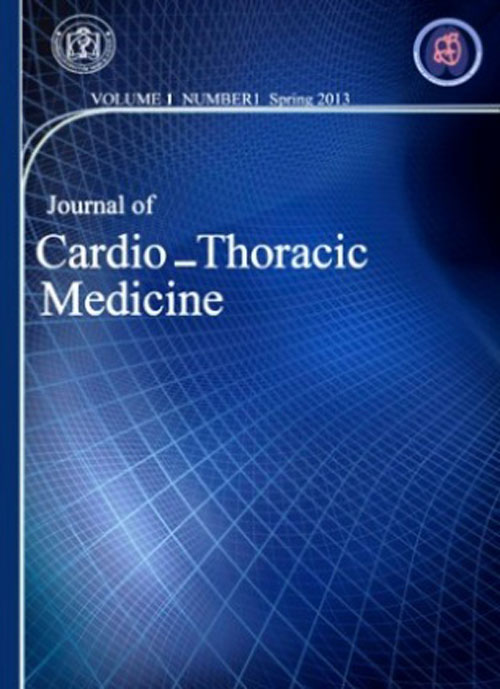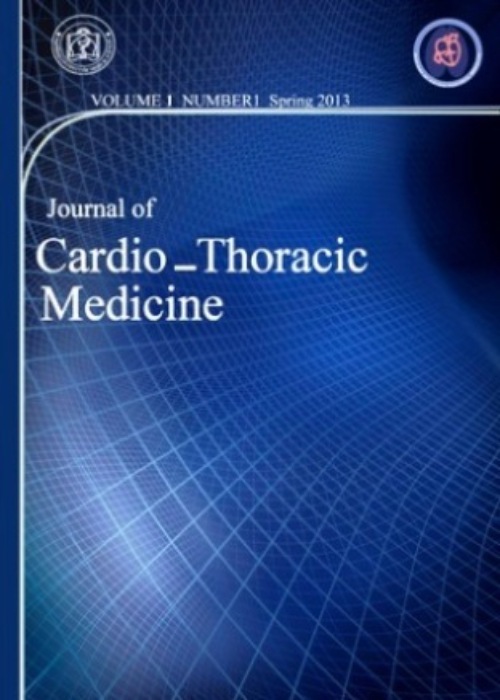فهرست مطالب

Journal of Cardio -Thoracic Medicine
Volume:9 Issue: 4, Autumn 2021
- تاریخ انتشار: 1400/10/12
- تعداد عناوین: 7
-
-
Pages 869-877IntroductionMetabolic syndrome (MetS) is characterised by a clustering of metabolic cardiovascular disease (CVD) risk factors that include: central obesity, impaired glucose metabolism, dyslipidaemia (hypertriglyceridemia, increased low-density lipoprotein [LDL], decreased high-density lipoprotein [HDL]) and hypertension. Paraoxynase-1 (PON1) is a plasma HDL associated protein that inhibits the oxidation of other lipoproteins. There is some evidence of reduced enzyme activity in subjects with metabolic syndrome. Curcumin is a natural polyphenol, it has been reported that curcumin has beneficial effects on several metabolic syndrome associated parameters. The aim of this study was to evaluate the effect of phospholipid complex of curcumin as an antioxidant on the activity of this enzyme in subjects with metabolic syndrome.Materials and MethodA double-blind randomised control study was undertaken in 80 patients with metabolic syndrome. Subjects in the intervention (n = 40) were given capsules of phospholipidated curcumin (1 g/day) for a period of 6 weeks. The control subjects (n = 40) received a placebo. Fasting blood samples of each person were obtained during the start and the end of the study. Paraoxonase activity was measured using a PON1 fluorescence Paraoxonase Assay Kit and Arylesterase activity was measured by photometeric method using a UV-Visible spectrophotometer.ResultsSerum paraoxonase enzyme activity did not change significantly between the curcumin treated group and the control group before the intervention (0.54 ± 0.18 U/µl versus 0.49 ± 0.14 U/µl; P > 0.05), nor did serum arylesteras activity change significantly between two study groups (152.67 [46.60 to 916.05] U/µl versus 129.77 [55.34 to 344.78] U/µl; P > 0.05). In addition, there was no significant difference in changes at baseline and after the intervention in serum PON1 activity between the curcumin treated group and the control group (-0.03±0.19 U/µl versus -0.04±0.18 U/µl; P > 0.05), nor was there a significant change in arylesteras activity (-12.36 [-88.83 to 110.24] U/µl versus -4.58 [-61.06 to 47.07] U/µl; P > 0.05).ConclusionPhospholipid fortified curcumin has no significant effect on serum PON1 activity.Keywords: metabolic syndrome, Curcumin, Paraoxonase-1
-
Pages 878-883IntroductionMetabolic and inflammatory disorders are widely described in COVID-19 disease by SARS-CoV-2, especially in advanced gravity stages, nevertheless, the increase in inflammatory and tissue damage biomarkers could identify patients with higher mortality risk since early disease stages.Material and MethodA retrospective Cohort study was performed to evaluate the progression pattern and mortality risk of proinflammatory (Ferritin and IL-6) and damage tissue biomarkers seric levels (LDH, CPK, CPK-MB and TnIc) since the beginning of the disease to end outcome considered, in this study, as death or recoveryResultsWe evaluated 120 patients with mean age 51±10 years. The CAT study showed in all patients bilateral polished glass lung lesions. The inflammatory and seric tissue injured biomarkers were significantly higher since the beginning of the hospitalization in patients who died compared with patients that survived (p = 0.01). The myocardial injury biomarkers (CPK-MB and TnIc) were significantly higher in severe gravity stages of deceased patients compared to patients who survived (p = 0.001 and 0.003 respectively) with a global mortality of 38.3% (n = 48). The mortality risk was extremely elevated (RR> 10) when inflammatory and tissue injury biomarkers showed seric levels 2 folds above normal values, showing survival of < 60% after tenth day since the beginning disease.ConclusionSince the beginning of COVID-19 disease by SARS CoV2 virus, patients show serum elevation in ferritin, LDH and CPK. This seric values were associated with higher mortality risk, when elevated 2 folds above normal values.Keywords: SARS-CoV-2, COVID-19, inflammatory Biomarkers, Tissue injury
-
Pages 884-890Introduction
Iatrogenic Cushing’s syndrome develops due to chronic exposure to excess glucocorticoids and is associated with increased morbidity and mortality if it remains unrecognized and untreated. Cushing’s syndrome resulting from long-term use of exogenous glucocorticoids is the commonest cause of iatrogenic Cushing’s syndrome. In India, cases of iatrogenic Cushing’s syndrome are commonly encountered, owing to the steroid abuse for respiratory conditions and chronic pains along with poor access to health care.
Method and materialsThis study was conducted in the Department of Respiratory Medicine, Himalayan Institute of Medical Science (HIMS), Swami Ram Nagar, Dehradun. Over a period of 12 months, subjects were recruited from the patients presenting to HIMS, Dehradun” with the primary diagnosis of obstructive airway disease after taking written informed consent.
ResultAfter a detailed history and examination and applying the inclusion and exclusion criteria, 384 consecutive patients diagnosed with Obstructive airway “disease were enrolled. Demographic data was recorded. Diagnosis of Iatrogenic Cushing syndrome was made on the basis of history of use of glucocorticoids and clinical examination. Most of the patients in the study population were > 60 years of age (34.29%) There was a male predominance in our study with 243 (63.28%) males and 141 (36.72%) females. Smoking was the major risk factor for COPD in comparison to biomass fuel, present in 85.05% and 15.95%, of patients respectively.
ConclusionIn our study, prevalence of iatrogenic Cushing syndrome in obstructive airway disease was 7.81%. This study highlights role of screening for iatrogenic Cushing syndrome in patients with obstructive airway disease with early intervention to prevent the side effects of chronic indiscriminate use of steroids.
Keywords: Chronic obstructive airway, disease (COPD, ASTHMA), Cushing Syndrome -
Pages 891-898IntroductionCovid-19 pandemic has put high pressure on the anesthesia healthcare workforce due to imposing heavy workload as well as high risk of disease transmission. Identifying the risk factors for the disease is the first step to reduce the risk of infection. We aimed to assess the prevalence and the risk factors of COVID-19 among anesthesia healthcare workers.Materials and MethodBetween June and September 2020, 199 members including faculty anesthesiologists working in public teaching hospitals, anesthesia assistants, anesthesia technicians, and nurses working in Covid-19 and non-Covid-19 care units were enrolled in this study. A questionnaire including demographics, medical history, job category, history of presence in areas with Covid-19 epidemic, use of safety tips, current clinical manifestations and the results of COVID-19 tests was sent by email to the healthcare workers. Evidence of COVID-19 disease according to WHO diagnostic recommendations, was assessed in all participants.ResultsOf 199 participants in our study, 43.7% were Covid-19 positive and 56.3% had no evidence of Covid-19 disease. Comparison of the two groups of personnel with and without Covid-19 disease showed no differences in demographics and blood groups. While, physicians were more infected than nurses and presence of infected cases in COVID zone was much longer. Regarding observance of safety points, there was no difference between the personnel with and without Covid-19 but using filtered N95 masks was significantly more prevalent in infected cases (p = 0.019). During follow-up, 38.0% of infected cases showed some evidence of end organ damages including cardiac complications in 4.3% and renal dysfunction in 4.3%.ConclusionOur study showed a high rate of Covid-19 infection in anesthesia personnel involving in the care centers of patients with Covid-19. Using filtered N95 masks could not effectively protect the personnel against Covid-19 infection. History of presence in epidemic areas and working in Covid-19 patients’ wards were identified as the main risk factor for Covid-19 infection among personnel.Keywords: COVID-19, Healthcare providers, Prevention
-
Pages 899-904IntroductionMaintaining a vascular access is a common procedure in neonates specifically for those who need prolonged hospitalization or intensive care support. This situation may happen several times among those with complex congenital anomalies therefore patency of central vein is a major concern at the time of re-cannulation. We evaluate the patency of internal jugular vein after previous open catheterization in this study.Material and MethodAll term neonates with documented internal jugular vein catheterization during 2008-2018 were enrolled in our study. Patients were fallowed for more than a year after catheter removal and internal jugular vein (IJV) patency was assessed by Doppler ultrasound.Results87 neonates were undergone central venous catheterization while just 18 were participated in our study protocol successfully. Mean age at the time of catheterization was 16.22±8.14 days. Doppler ultrasound assessment was arranged meanly 29.2±6.53 months after catheter removal. Doppler ultrasound studies revealed normal patency in 38.9%, stenotic in 27.8% and occluded in 33.3% of cases. Mean age of catheterization was significantly lower in occluded IJV group while no meaningful correlation was detected between venous thrombosis and patient gender or catheter maintenance time. IJV occlusion rate was not related to the indication of catheterizationConclusionIt is necessary to keep in mind the probability of IJV thrombosis and occlusion among those patients with the history of early neonatal ICU admission and CV catheterization. Ultrasound evaluation could be helpful while re-cannulation will be the best option for those with patent IJV to save the contra lateral venous patency.Keywords: central vein, Catheterization, jugular, neonate
-
Pages 905-906
In this case report, we have explained a patient with Hydatid cyst of the lung. He aged 29 years weighted 61 kg. The most common symptom was provocative cough and there was a large cystic lesion on computed tomography (CT) scan that had filled approximately three-quarters of the left hemithorax (Figure 1). The patient had a positive hydatid agglutination test (HAT) test and was diagnosed with a vague hydatid cyst of the left lung and underwent left posterolateral thorachotomy in August 2021. After removing the cyst membrane, the patient's pericyst lesion (10 x 15 cm) was completely excised (Figure 2). Figure 3 shows a pulmonary hydatid cyst in which the congested blood vessels in the pricyst with fibrofatty collagenous tissue have been revealed.
Keywords: Hydatid Cyst, Lung, Surgery -
Pages 907-912
A mycotic aortic aneurysm (MAA), synonymously known as infected aortic aneurysm, is an aortic aneurysm due to infection. Mycotic aortic aneurysm most commonly develops through microbial inoculation of the diseased aortic endothelium during bacteremia. In this study we presented 2 Mycotic aortic aneurysm cases. In the first case the patient is a 50-year-old farmer who presented with a complaint of abdominal pain. The patient was consulted with the vascular surgery service for the diagnosis of ruptured abdominal aneurysm. The patient was prepared for surgery of a ruptured abdominal aortic aneurysm. After surgery, the patient's blood culture was reported negative after 72 hours, but the patient's aneurysm sac tissue culture reported Citrobacter freundii. The patient's antibiotic treatment regimen was changed according to the performed antibiogram. In another case A 65 year’s old male who was admitted in neurology ward was consulted with us, because of a pulsatile abdominal mass. The patient had Alzheimer disease and Brucellosis and didn’t receive a complete duration treatment for his Brucellosis. On surgery, we bypassed the defect and covered the graft with peritoneum. In first case the patient's blood culture was reported negative after 72 hours, but the patient's aneurysm sac tissue culture reported Citrobacter freundii. The patient's antibiotic treatment regimen was changed according to the performed antibiogram. In second case he was discharged without any surgical complication and on follow –up visit (7 months later) he didn’t have any complaint.
Keywords: aorta, Mycotic, Aneurysm, Mycotic aneurysm, Aortic Aneurysm


